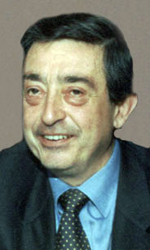 Giuseppe Anastasi
Giuseppe Anastasi
Prof. Giuseppe Anastasi, University Professor of Human Anatomy at the Medicine
Faculty and Surgery of the University of the Studies of Messina since 1990
Since 1995 he is the Coordinator of the Integrated Course of Normal Human Anatomy. From 1998 to March 2005 he has been the President of the Course of Bachelor in Odontology and Dental Prosthetics.
Associate Member of the Italian Society of Anatomy, of the Italian Society of Histochemistry, of the International Group for Scientific Research in Stomatology and Odontology (GIRSO) in which it carries out the role of treasurer and other scientific societies.
He is the author of approximately 180 publications, a greater part of which are published on reviews of greatest international prestige. Great part of the thematic ones of the jobs is oriented on regarding lines of search the study of the "costameri" of the skeletal and cardiac human muscle, with particular reference to the distrofina-glycoprotein-associate
proteins that constitute the complex and the vinculina-talina-integrine system, implied, between the other, in instauration of the greater part of the muscular dystrophies.
Its articles are oriented also to the study of the Neuroanatomy, with particular attention to the nuclei of the base and the posture, and to the study of the dental enamel the ameloblasts comprised. Of relief they have been turns out the shape of crystals of the enamel and the modalities of deposition of the same enamel. He is also the author of some witnesses of Human Anatomy and Clinical Anatomy, he adopts from the Course of Bachelor in Medicine and Surgery to you, in Odontology and Dental Prosthetics and Motor Sciences, beyond that from the Course of short Bachelor.
MECHANISMS OF POSTURAL CONTROL
Posture is the total position of body and joints, one with other, and their position regard to neighbouring space. In details, the posture is the position of body segments one with other and in the context of outside ambient. Motor systems, besides, must to take into account of distribution of body mass and to made postural adjustments characteristic of particular movements effectuated.
In order to execute each single movement, it is necessary to effect postural adjustments which must be integrated with voluntary movement. The postural adjustments made up important behavioural roles, they support head and body against the force of gravity, they maintain the centre of body mass balanced at inner of stay base and, finally, they balance body segments which act as support when other segments are in movement.
The postural adjustments are made up through two mechanisms: anticipatory mechanism, o feed-forward mechanisms, and compensatory mechanisms, or feed-back mechanisms. The anticipatory mechanisms generate preprogrammate responses which contribute at stability and are anticipatory at regard to beginning of voluntary movements. The compensatory mechanisms are extremely rapid responses; these responses are also improved by exercise and learning.
All these movements are induced by cutaneous, vestibular, muscular and visual receptors. Besides, in order to integrate the posture, the postural responses utilize cortical, troncoencephalic and spinal circuits.
The cerebral cortex is responsible of anticipatory mechanisms which are evocated by visual receptors. The troncoencephalic circuits are represented by medial indirect system, vestibulum-spinal systems, reticulum-spinal system and tectum-spinal system, which controls proximal muscles, and by lateral indirect system, rubrum-spinal, which controls distal muscles utilized during execution of movement.
Spinal circuits play a key role in the execution of all movements, since they are more simple expression of movement direct about an aim. Besides, the adaptation of postural control requires the integrity of cerebellum which acts as comparator in order to correct the errors of movements comparing the intention with execution.